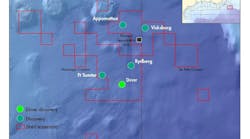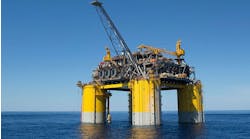Industry must adjust to $14/bbl price
William FurlowThere is no question that the future of offshore exploration lies in deep and ultra-deep water water depth plays. Projects already underway in theaters ranging from the Gulf of Mexico to West Africa and the Campos Basin have proven there is plenty of oil waiting to be recovered beyond the 10,000 ft water depth contour.
Technology Editor
According to figures released by Shell Deepwater Development, there have been to date 52 deepwater discoveries in the US Gulf of Mexico, 20 offshore Brazil and 17 in deepwater fields off West Africa for a combined total of almost 23 billion boe. These numbers, however impressive, represent only a fraction of the potential in these new theatres. In most cases, the geology is still little understood.
Before the industry can unlock the deepwater and ultra-deepwater potential, there are a variety of technological, environmental, and regulatory challenges that must be overcome. David Walker, Manager of Deepwater Technology for London-based BP, borrowed Daniel Yergin's title "The Prize" when he spoke of the potential of deepwater and ultra-deepwater plays at the recent Deepwater Technology Conference (DOT ' 98, held in New Orleans in November. Walker, and others, are convinced that the future of deepwater can only be realized through sound environmental, technological, and safety innovations.
The environmental question
Of these three categories, Walker lists environmental concerns as paramount. He is not alone. Richard Pattarozzi, President of New Orleans-based Shell Deepwater Development, also speaking at DOT '98, concurred with the observation that environmental constraints are the single biggest challenge the industry faces. It is not a question of operators being friendly to the environment - it is a political and public relations issue.If government or activist groups do not feel an operator is protecting the environment, then it is quite possible the entire industry could be shut out of a region. This, in fact, has happened in parts of the North Sea and Gulf of Mexico. To guard against such a disaster, operators must not only minimize the impact on the environment, but make sure these efforts answer the questions and concerns of regulators and the public. As Walker said, this concern comes first before technology and safety because it has the potential to close down, not just a single project, but an entire region.
Drilling-production gap
Advances in drilling and production technology are obviously required to not only reach, but profitably exploit deepwater and ultra-deepwater plays. Pattarozzi pointed out the gap that currently exists between drilling technology and production technology. Currently, the industry can drill in water up to 7,700 ft, but the deepest production is occurring at only 5,300 ft.The lag appears to be about one decade between the time point at which an operator develops the technology to drill at a new record depth, and when the technology is acquired to develop at the same depth. Whether this lag can be shortened is a more complex question than one might think. In frontier territory, it may well take 10 years from the spudding of the first exploration well to the time when the first field is fully delineated and ready for a production solution.
From a drilling standpoint, there are a number of technological challenges that the industry is facing. Pattarozzi lists several, including the ability to profitably drill and produce in water depths beyond 5,000 ft.
Deepwater subsalt
One of the biggest obstacles the industry will be facing is the vast expanse of subsalt in the ultra-deepwater region of the Gulf of Mexico. While drilling subsalt is a challenge at any depth, designing an ultra-deep well that may involve not only a subsalt rubble zone, but possibly a shallow water flow zone. Spanning such conditions borders on impossible using conventional casing programs.An extremely large bore casing program or innovative technology would be required to drill such a well with a bottom hole ID large enough to be profitable. Due to the difficult nature of imaging through salt, and the added challenge of shooting a deepwater formation, it is quite possible that such a high-end well will result in a very expensive dry hole.
In this particular area, recent innovations by Shell Technology Ventures and its partner Halliburton in the area of solid expandable casing may offer an elegant and economical solution to this problem. Such casing can be run downhole and expanded via an expansion pig to near the ID of the casing it was run through.
In fact, underreaming can bring the expandable casing string to almost exactly the same ID as the string it was run through. Such technology would mean easier installation and a larger production annulus.
FPSOs with drilling
Pattarozzi also listed subsea capability and reliability among industry goals. He said subsea systems may be the dominant deepwater development solution of the future. Hurdles to overcome in this arena include designing high pressure systems, cost effective paraffin inhibitors, and better and less frequent well intervention techniques, as well as overcoming hydrate problems on long, cold offsets.The addition of a drilling function, preferably riserless, to floating production, storage, and offloading (FPSO) systems, could conceivably make profitable deepwater plays anywhere in the world with minimum reliance on shore-based facilities. Work is now progressing on FPSOs with drilling capabilities.
Designs for the first of these have been presented by Kvaerner. The vessel would offer a cost-effective all-in-one solution for drilling, production, and workover activities for reservoir and production management. Such a vessel would be attractive in remote deepwater environments with high drilling and well maintenance requirements, such as the Norwegian Sea, West of the Shetlands, the Gulf of Mexico, and offshore Brazil.
Such a stand-alone concept is a prime example of the sobering role technology must play in the future of deepwater drilling and development. Technology of the future will have to offer a short-term economic dividend to play a role in this developing market.
$14/bbl oil prices
Pattarrozi, in his DOT '98 remarks, said that like it or not, $14/bbl oil has been the average price over the last 100 years. There is no reason to expect this to change in the future. He suggested that to compete in such an environment, operators must use new technology to solve cost problems, while at the same time overcoming capability limitations. In this respect, it is not enough for new technology to affect the bottom hole. It also must affect the bottom line.A companion benefit to advancements in offshore technology is the removal of the individual from the critical path. With rig floor automation becoming the standard rather than the exception offshore, the running joke is that the ultimate rig crew will be a man and his dog. As the joke goes, the man's job is to feed the dog, while the dog's job is to make sure the man doesn't touch anything.
Copyright 1998 Oil & Gas Journal. All Rights Reserved.


